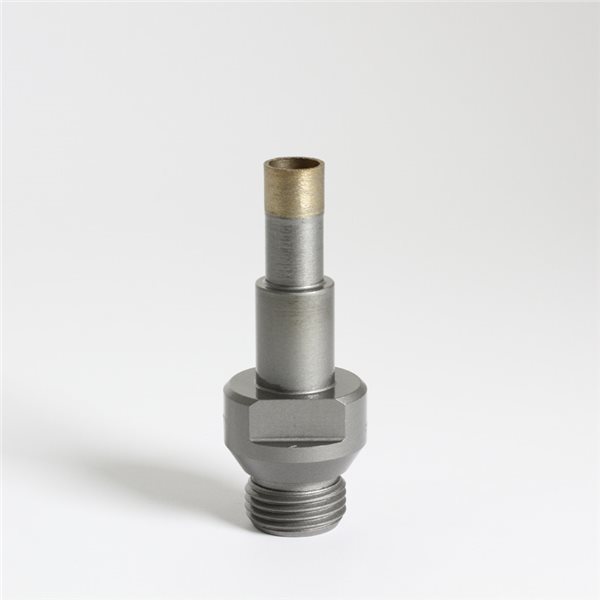Diamond Core Drill - Sintered - 22mm - Professional
8351
Sintered diamond core drills, unlike plated drills, have diamond content throughout the tip of the drill, so as it wears down you can run it through a dressing stick and expose new diamonds. This extends the lifespan significantly. Other advantages are apparent in the speed and efficiency of drilling.
These drills are the choice of professionals and represent the best value and performance per hole.
Advantages:
- Multiple layers of diamond
- Super smooth finish
- Longest lasting drill
- Most cost effective
With sintered drills, it is however important to have a continuous coolant feed through the centre of the drill to prevent damaging the drill and the work. It is also highly recommended that you use a drill press. We offer sintered drills with a Belgian 1/2 inch connection. We also offer adaptors to match your specific water feed system.
Diamond Drilling Glass
To achieve the best results in drilling glass the following points should be taken into consideration:
1. A drill press or stand drill will always give better results and longer drill life than hand held drilling.
2. In an ideal world the peripheral working speed of a diamond core drill for glass would be about 5 metres per second, representing about 9500 revolutions per minute (rpm) for a 10mm drill. As most standard electric drills are made to run at a maximum of 3500 rpm it’s clear from this that we can’t achieve optimal drilling speeds until we are drilling with a 28mm drill.
As most manufacturers today make core drills that will operate sufficiently from 1 metre per second we can run a 6mm drill on a machine running at 3500 rpm. Consequently, every drill size smaller than 6mm isn’t running efficiently in a standard electric drill and requires special care, i.e. plenty of coolant (very cold water preferably with a cooling additive), a drill stand or some means of holding the drill in a steady position and sufficient coolant pressure to ensure that the contact area is kept clear of debris.
3. Most drills from 3mm up are core drills, that is to say a drill with a hole in the centre to allow coolant to flow freely. For drills up to 6-7mm it’s necessary to ensure that the core remains free of debris and this can be achieved either by using a high pressure coolant supply or regularly removing the drill from the work to allow the coolant to flush the work area and clear the core of the drill.
4. Don’t forget that you are essentially grinding glass and not drilling in the traditional sense. Your greatest enemy is heat build-up as this will lead to micro cracks in your work and possibly premature drill tip failure.
5. Never drill constantly. Always lift the drill out of the work at very regular intervals, the smaller the drill diameter the more often.
Tipps
To use these drills in a pillar drill, knock out the chuck assembly using a hammer and a block of wood, and replace with 202.003 Belgian ½” Core Drill Cooling System.
For occasional use in a standard chuck fitting, either on a pillar drill or a hand drill on a stand, use 201.721 Flushing System - Cooling Head & 201.936 Adaptor for Glass Drills - 1/2 inch Belgian Thread to 10mm Thread.
Specific References
8351 0.137000



















